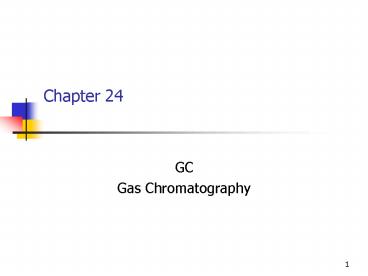GC - PowerPoint PPT Presentation
Title:
GC
Description:
Chapter 24 GC Gas Chromatography – PowerPoint PPT presentation
Number of Views:93
Avg rating:3.0/5.0
Title: GC
1
Chapter 24
- GC
- Gas Chromatography
2
GC
- Mechanism of separation is primarily volatility.
- Difference in boiling point, vapor pressure etc.
- What controls this?
- Molecule to molecule bonds
- Van der Waals, dipole dipole for example.
- Molecular Weight
3
Volatility
- Boiling points
- H2S -60 C
- H2Se -45 C
- H2Te -15 C
- H2O 100 C (why is this different)
4
Molecular Weight
- Methane -164 C
- Butane -0.5 C
- Pentane 36 C
- Hexane 69 C
- Octane 125 C
- Decane 174 C
5
GC ExampleCholesterol and other lipids in bone
(trimethylsilane)
6
Combustion Result (CO2) Mass Spec Detection
7
Block Diagram of GC System
8
Block Items
- Carrier gas - He, N2, or H2
- Injector - usually septum introduction
- Column with Stationary phase a nonvolatile
liquid carbowax is a common example - Detector converts chemical to electrical
information. - Last three items are held at elevated
temperatures, usually
9
Column
- Where separation takes place.
- Open tube
- Packed
10
(No Transcript)
11
Side View of Column
12
Open Tube Types
13
Low Temperature Separation of an Alcohol Mix -
Packed Column Carbowax FID
14
Open Tube Separation of the Headspace of a Can of
Beer Carbon Column
15
Chromatogram
16
Stationary Phases
17
After volatility we can work with polarity
differences.
- Simple rule is that likes dissolve likes. We
could determine log P or just use our chemical
intuition. - There is not a big effect here so a short list of
columns will usually get the job done.
18
(No Transcript)
19
Nonpolar Column Polar Column
20
Specialized Stationary Phases
- Zeolites (Molecular Sieves)
- Alumina
- Chiral stationary phases
21
(No Transcript)
22
(No Transcript)
23
(No Transcript)
24
Packed Columns
- Still find their uses.
- Can handle larger samples.
- Have a support coated with stationary phase
- Support often diatomite.
- Issues with active sites.
25
Retention Index.
- A measure of retention compared to the n-alkanes.
- The alkanes are assigned a number that is 100
times the number of carbons. There is related in
a linear way to the log tr
26
(No Transcript)
27
Retention Index
Where N is the number of carbons in the higher
alkane n is the number of carbons in the lower
alkane tr is the adjusted retention time
28
What if an analysis is too slow?
- Temperature programming
- Increase temp as the run progresses
- Pressure programming
- Increase pressure as the run progresses
- Advantage is that pressure can be quickly
returned to original value where it takes time to
reduce the heat.
29
(No Transcript)
30
(No Transcript)
31
(No Transcript)
32
Carrier Gas Considerations
33
Sample Injection
- Manual syringe through the septum port
- Automatic syringe through the septum port.
34
Split Injector
35
Split less Injection
36
(No Transcript)
37
(No Transcript)
38
Detectors
- A transducer converts chemical information to
electrical signal. Most tell us no additional
information other than there is a detector
response. - TCD
- FID
- ECD
- Others (Mass spec)
39
Peak Identification / Quantification
- Co-injection.
- Run on multiple columns of different polarity.
- Area of peak is proportional to amount of sample.
Different samples can have different responses. - Area (Gaussian peak) 1.064peak htw1/2
40
Internal Standard
- A compound added that is close in nature to the
compound being analyzed. Gets around a variety
of problems.
41
Thermal Conductivity Detector
42
(No Transcript)
43
Flame Ionization Detection
44
Less common detectors
- Nitrogen Phosphorus - burner heats a glass bead
that contains Rb2SO4 - 104 to 106 greater
response to N and P over C. - Flame Photometric - P, S, Pb, Sn
- Photo ionization detector. Aromatics,
unsaturated compounds - Sulfur (nitrogen) chemiluminescence detector
- SO mixed with O3 from flame 107 over carbon
- Atomic emission
45
ECD of Atmosphere
46
GC of Natural Gas
47
Mass Spectroscopy
- Since full spectra are collected at each time
point then we can selectively look for our
analyte of interest.
48
(No Transcript)
49
(No Transcript)
50
Sample Preparation
- Derivatization
- Solid Phase Micro extraction
- Purge and trap
51
(No Transcript)
52
(No Transcript)
53
Example of Solid Phase Micro extraction
54
(No Transcript)
55
Method Development
- Goal of Analysis
- Sample preparation
- Detector
- Column
- Injection
56
(No Transcript)
57
Resolution Improvement
- Longer Column
- Narrower Column
- Thinner stationary phase
- Different Stationary phase
58
Injection Comparison
- Split Injection
- Concentrated sample
- High resolution
- Dirty samples
- Thermal decomposition issues
59
Injection Comparisons
- Splitless
- Dilute samples
- High resolution
- Requires solvent trapping or cold trapping
- On-column injection
- Best for quantification of analytes
- For thermally sensitive compounds
- Has lower resolution































